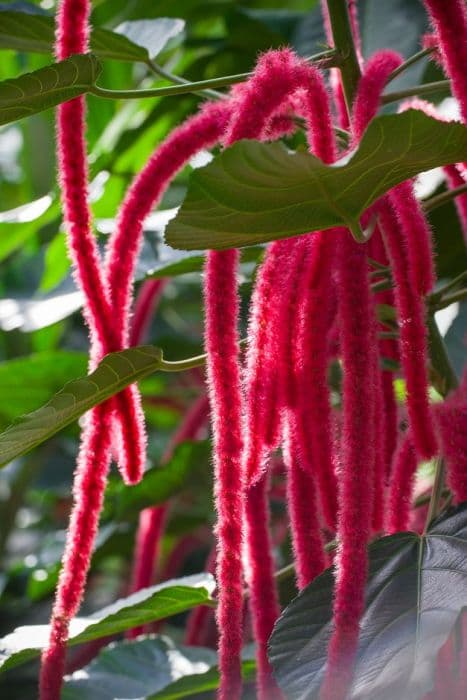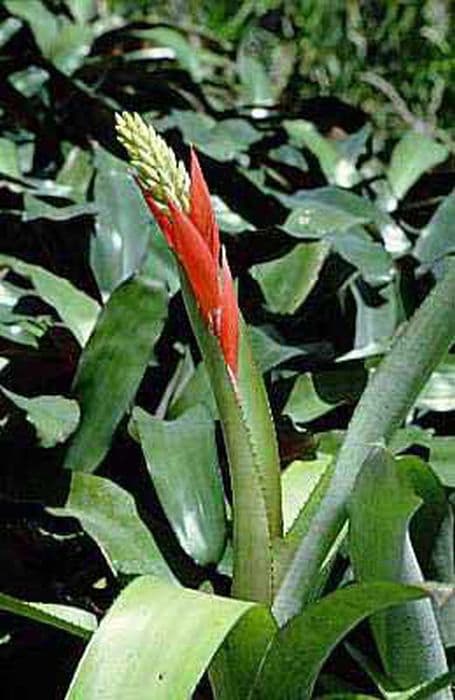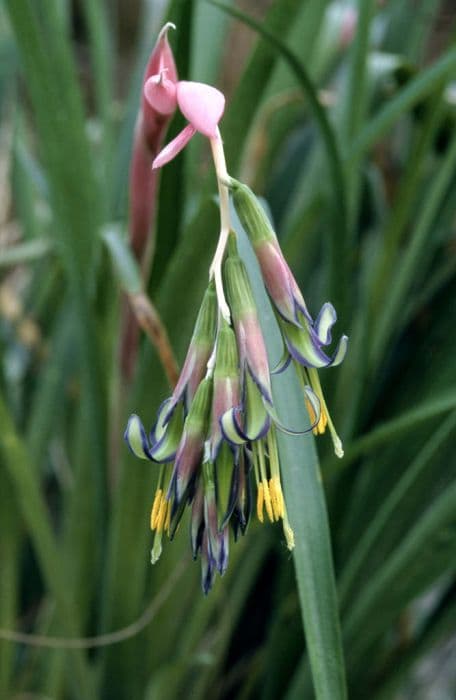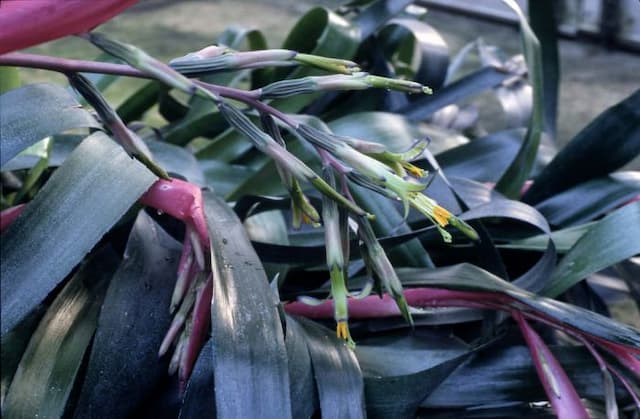Air Plant Tillandsia punctulata

ABOUT
The plant in question, commonly known as air plant, is a fascinating species with a rather distinct look. It commonly has a rosette of thin, tapering leaves that are a vibrant green color. The leaves often possess a silvery-gray coating, which gives them a frosted appearance, and they may develop a reddish or purple tint when the plant is about to bloom. The texture of the leaves can be described as slightly rough or scaly due to the presence of tiny structures that help the plant absorb water and nutrients from the air. The air plant is known for its remarkable ability to thrive without soil, clinging to various surfaces with its roots used primarily for anchoring. The plant produces a flower spike from the center of the rosette, adorned with brilliant flowers of varying colors, depending on the specific species. These flowers can add a splash of color and beauty to the otherwise muted tones of the foliage. Overall, the air plant's appearance is quite striking and it can be a conversation starter owing to its unique growing habits and structural adaptations.
About this plant
 Names
NamesFamily
Bromeliaceae
Synonyms
Punctulate Airplant, Spotted Airplant
Common names
Tillandsia stenoura, Tillandsia ballii, Tillandsia anceps, Tillandsia glaziovii, Tillandsia boliviana, Tillandsia grandiflora, Tillandsia seleriana, Tillandsia tessellata.
 Toxicity
ToxicityTo humans
Tillandsia punctulata, commonly known as an air plant, is not known to be toxic to humans. These plants are generally considered safe, and there is a lack of evidence suggesting any part of the air plant is poisonous upon ingestion. Therefore, no specific symptoms of poisoning or consequences from ingesting parts of the air plant are commonly reported.
To pets
Tillandsia punctulata, widely recognized as an air plant, is not considered toxic to pets. They are usually safe for pets, and there is no significant information available indicating that any part of the air plant would cause poisoning if ingested by pets. Hence, there are no specific symptoms associated with poisoning from ingestion of this plant by animals.
 Characteristics
CharacteristicsLife cycle
Perennials
Foliage type
Evergreen
Color of leaves
Green
Flower color
Varies
Height
4-8 inches (10-20 cm)
Spread
4-8 inches (10-20 cm)
Plant type
Herb
Hardiness zones
10
Native area
Central America
Benefits
 General Benefits
General Benefits- Easy Maintenance: Tillandsia punctulata, commonly known as air plant, does not require soil, making it an easy-to-care-for houseplant that only needs occasional watering and indirect light.
- Decorative Versatility: With its unique appearance, it can be used to add an aesthetic touch to various decors and can be creatively displayed in glass globes, mounted on walls, or placed among other plants.
- Drought Resistant: Adapted to withstand periods of drought, this air plant is suitable for environments where watering is infrequent or for people who travel often.
- Non-Toxic to Pets: Being non-toxic, it is a safe option for households with pets that may be curious about the plants in their environment.
- Enhances Humidity: By misting the air plant, it can help increase the humidity in a room, which can be beneficial for both human skin and other houseplants.
- Space Efficiency: Due to their compact size and lack of need for soil, they are excellent for small living spaces or offices where space may be limited.
- Educational Interest: It can serve as an educational tool to teach about epiphytic plants and their adaptations to different environments.
 Medical Properties
Medical Properties- This plant is not used for medical purposes.
 Air-purifying Qualities
Air-purifying QualitiesThis plant is not specifically known for air purifying qualities.
 Other Uses
Other Uses- Biological Art: Tillandsia punctulata is often used in biological art installations due to its unique appearance, allowing artists to create living sculptures and compositions.
- Education: This plant is used in educational settings to teach students about epiphytism and adaptations of plants in different ecosystems.
- Humidity Indicator: In some households, Tillandsia punctulata is used as a natural indicator of humidity levels due to its preference for moist air.
- Wedding Decor: Because of its aesthetic appeal and ease of arrangement, Tillandsia punctulata is incorporated into wedding bouquets, centerpieces, and venue decorations.
- Gift Plant: It’s a popular gift plant because of its minimal care requirements, making it an ideal present for those not adept at caring for plants.
- Jewelry: Live Tillandsia punctulata plants are sometimes used in the crafting of bio-jewelry, such as necklaces and earrings.
- Fashion Accessories: In avant-garde fashion, Tillandsia punctulata can be used to adorn hats or headpieces for a natural, organic look.
- Photography Props: Photographers use Tillandsia punctulata to create green, natural settings in their studio or outdoor shoots, adding texture and life to their photos.
- Crowning Euphorbia: Some hobbyists affix Tillandsia punctulata atop euphorbia cacti, which gives a contrasting yet symbiotic visual display.
- Religious Ceremonies: In certain cultures, Tillandsia punctulata may be used in religious rituals as a symbol of air and life.
Interesting Facts
 Feng Shui
Feng ShuiThe Tillandsia, commonly known as air plant, can be used in Feng Shui as a symbol of growth and flowing energy due to its unique ability to grow without soil. It can be placed in the wealth area of the home, which is the southeast corner, to attract prosperity or in the personal growth area located in the northeast to enhance self-improvement and knowledge.
 Zodiac Sign Compitability
Zodiac Sign CompitabilityThe air plant is not used in astrology practice.
 Plant Symbolism
Plant Symbolism- Resilience: As an epiphyte that can grow without soil, Tillandsia punctulata, commonly known as Air Plant, symbolizes resilience and the ability to thrive in challenging environments.
- Independence: Air Plants can absorb moisture and nutrients through their leaves from the air, representing self-reliance and independence.
- Freedom: Without the need for soil, Air Plants are not rooted in one place, which can signify freedom and a free-spirited nature.
- Uniqueness: With its distinctive growth habit and appearance, the Air Plant represents uniqueness and encourages the celebration of one’s individuality.
- Adaptability: The ability of Tillandsia punctulata to adapt to various lighting conditions makes it a symbol of adaptability and flexibility.
 Water
WaterAir plants like the Tillandsia punctulata, commonly known as air plant, should be watered by misting thoroughly two to three times a week. It's important to shake off any excess water to prevent rot. In drier conditions, increase the frequency but in a humid climate, watering once a week might suffice. Every two to three weeks, the plant can benefit from being submerged in water for about an hour. Use approximately 1/4 gallon of water for each soaking session.
 Light
LightAir plants such as Tillandsia punctulata thrive in bright, indirect sunlight. The ideal spot for this air plant is a room with lots of windows that allow for plenty of natural light without direct exposure to the harsh rays of the sun, particularly during the hot afternoon hours. An east or west-facing window is often a good choice.
 Temperature
TemperatureThe ideal temperature range for a Tillandsia punctulata is between 50°F and 90°F. They can survive short periods of colder or hotter temperatures but should not be exposed to temperatures below 45°F or above 95°F as this could harm the plant. The most comfortable temperature for optimal growth is around 70°F to 85°F.
 Pruning
PruningPruning an air plant such as Tillandsia punctulata is generally not necessary except to remove dead or brown leaves to enhance its appearance. This can be done at any time of the year, as needed. If pruning to encourage a particular shape or to maintain a compact size, it's best to do so during the growing season.
 Cleaning
CleaningAs needed
 Soil
SoilTillandsia punctulata, commonly known as air plants, do not require soil as they absorb moisture and nutrients through their leaves. They should be mounted on a substrate that allows for air circulation, such as wood, cork, or a specialized air plant frame. The ideal pH level for an air plant is not applicable since they do not grow in soil.
 Repotting
RepottingAir plants like Tillandsia punctulata do not need repotting as they are not planted in soil. They grow attached to hosts like trees or rocks and get their nutrients from the air, water, and debris around them. Therefore, there is no need to repot these plants.
 Humidity & Misting
Humidity & MistingTillandsia punctulata thrives in high humidity environments, ideally between 50% to 70%. Maintaining adequate humidity is crucial for their health, as they absorb water through the leaves from the surrounding air.
 Suitable locations
Suitable locationsIndoor
Place in bright, indirect light indoors.
Outdoor
Hang in dappled light; protect from frost.
Hardiness zone
9-11 USDA
 Life cycle
Life cycleTillandsia punctulata, commonly known as air plant, begins its life cycle when seed dispersal occurs, typically through wind or animals, allowing it to anchor onto suitable substrates, often trees or rocks. Germination follows, with the seed developing into a small plantlet, which absorbs water and nutrients from the air through specialized leaves covered in trichomes. The juvenile stage sees the plant growing gradually, forming a rosette of leaves and becoming more resilient to environmental conditions. As it reaches maturity, the air plant produces a colorful inflorescence, which is a spike or branched structure, that signals the flowering stage, where pollination by birds, wind, or insects takes place. Following successful pollination, seeds are produced, and the cycle continues, while the parent plant slowly begins to die after expending its energy on reproduction. This process can take several years, with some plants producing offsets, or "pups," at their base before or after flowering, allowing for vegetative propagation and the continuation of the species.
 Propogation
PropogationPropogation time
Spring-Summer
The most popular method for propagating Tillandsia punctulata, commonly known as the Spotted Air Plant, is through offsets, also called "pups." These are small, clone plants that form at the base of the parent plant after it has flowered. To propagate using offsets, you should wait until they have reached about one-third the size of the parent plant. Carefully detach them with a gentle twist or by using a pair of sterilized scissors or knife, making sure not to damage the base of the pup or the mother plant. Once removed, the pups can be placed in their own location where they will eventually grow into mature air plants, following the same care requirements as their parent. This typically happens during the spring or early summer, which is the best time for removal and establishment of pups.









